Saturday’s boardgaming consisted of two games: Archipelago and Terra Mystica, before D&D kicked in.
Archipelago
is something of a controversial game on the ‘Geek, mainly because it has a way for every player to lose; the players need to co-operate enough to stop that happening, but it is still every man for himself. It’s made trickier by hidden victory conditions. Each player knows a open victory condition and one secret victory condition, but everyone has their own condition, and so only part of the puzzle is known. It rewards play in a generalist manner – you want to be good at a number of things, because they might just be the way to win!
The game is beautiful, though. Delightful graphics on the components, especially the tiles that make up the board!
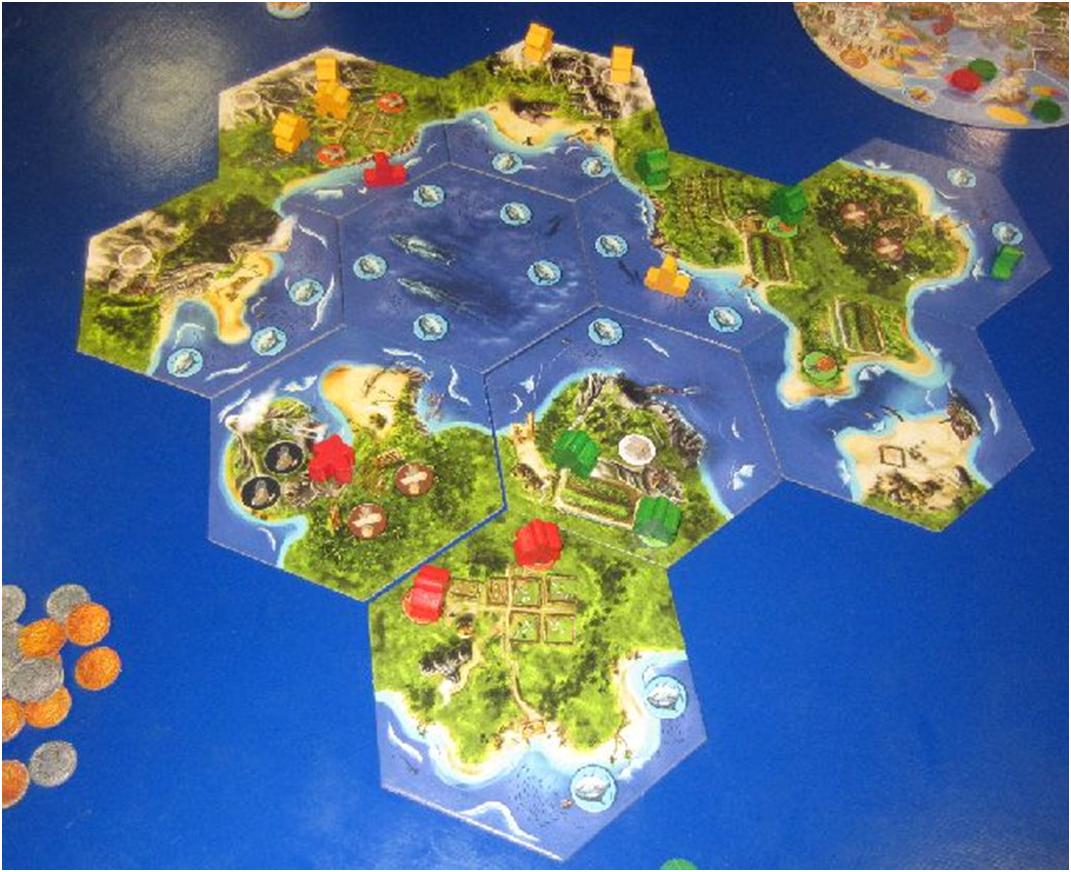
This game was a three-player affair. I played green, Sarah played red and David played yellow. Archipelago offers three sets of cards that give end-game conditions along with the victory conditions, thus allowing the game to go for varying lengths. This game was meant to be a medium game that, under normal circumstances, should have taken the three of us about 60 minutes. This was not a normal game! Like the victory conditions, the end-game conditions are also hidden; each player knows one, and if any are fulfilled the game ends. In this case, the game would end if there were 8 progress cards in play, 5 cities in play or 5 markets in play. Hardly a city or market got built during the game, and so it just went on and on and on.
Well, a little under two hours in total, but it felt like longer. (It didn’t help that I was actually very tired, which always causes my time perception to get wonky). After we placed our starting hexes, it was revealed that the major victory condition was number of fruit – and I’d just placed a tile with a lot of fruit trees on it. Sarah was not impressed.
However, despite the fruit trees, there was a distinct lack of stone available. I built a Sawmill and David built the Irrigation Canals (double wood and fruit production respectively) from the Evolution Cards, but my hope of constructing cities and temples receded as each new hex I explored had a lack of stone. David had stone, but he wasn’t using it – and his workmen were quite happy to jump on my fruit trees after I abandoned them to get some wood. Did I say “some” wood? I meant a lot of it, because that was my hidden victory condition.
Sarah was doing the bulk of the exploring. David did a little, but the edges of the map quickly proved troublesome for placing new tiles, especially in David’s case. Sarah built the first city of the game to deny me a little wood, but I gave her a fruit as a bribe. Soon, most of the fruit was gone from the supply, hoarded by all of us for the end-game scoring. I’d had the early lead, but I’d been giving up fruit to the markets so that I could make some money; I found money very tight this game.
The rebel population rose quickly, despite our efforts to keep it down, and the game could have easily ended if either Sarah or I (at various times) had been the secret rebel wanting the game to end in a revolt. Neither of us was, however. Sarah was most unhappy with her position. She’d gained a lot of exploration tiles (her secret victory condition), but was having trouble collecting resources. I was moderately happy with mine, though the lack of buildings was concerning, and David, despite potentially being in the strongest position, was not parleying that into a position of strength. He was harvesting and not spending; thus, he had a lack of potential victory points.
The strangest part of the game was that I was able to take over abandoned ports, twice (all the ports in the game). Both Sarah and David abandoned them as they needed their workers elsewhere, and I just strolled in to take them. Ports weren’t worth anything at the end of the game, but it was rather unusual to see them taken over like that!
With the rise in rebel activity, we finally built some temples. I finally found more stone and built a temple for myself, and then recruited more workers in areas where temples had been constructed by Dave and Sarah, reducing our need for extra resources to stop the revolt, and also giving us more of a buffer.
Rather significant to the final result: I was able to build the Cathedral, which reduced the rebel count as well as giving me a couple of victory points. David had bought two progress cards worth victory points, but hadn’t constructed either. One was the lighthouse, which my taking over of his port made it a fair bit more difficult for him to build it!
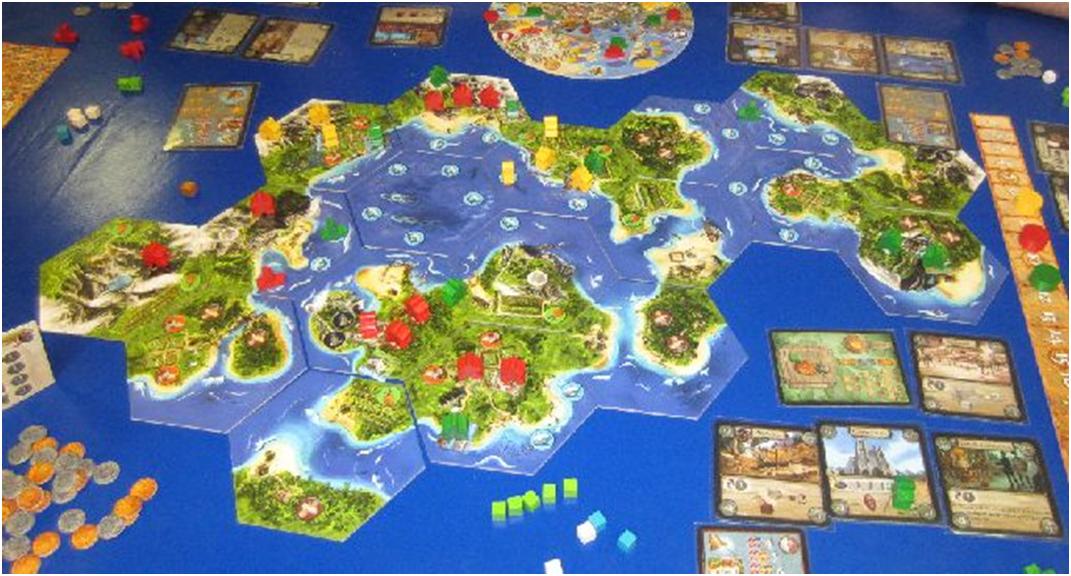
David had some problem distinguishing between progress and character cards, especially when they were rotated. (Sarah and I had no problems there at all), and so prematurely revealed his end-game condition: eight progress cards. We were on seven, and so there’d be only one more turn. I was worried that David would take the chance to build his wonders, but he didn’t do so. Ultimately, the game ended without much difference in the positions of us, and so we could get to end-game scoring.
David, as expected, gained 4 points from the major victory condition (Fruit). I gained 3 points, and Sarah gained 2. David’s victory condition was money, and he’d gathered a lot of it during the game with the aid of a financial planner. I had only one solitary coin and so took 3rd position: David 3, Sarah 2 and Merric 1. Sarah’s condition was based on number of exploration markers; something I should have seen. She was surprised by how few I had, as she’d not noticed me spending them to overcome challenges, but I still had second place. David had none remaining. Sarah 3, Merric 2, David 0. Finally, my own victory condition was cities plus wood, and here I was the undisputed leader. Merric 3, Sarah 2, David 0.
This left Sarah and I tied on 9 points apiece, but I still had my Cathedral. Its two victory points were enough to give me the game. Sarah remarked that she was in a much better position than she thought; this is often the case with Archipelago. Generalising does help; it is just notable that this game was particularly bad for our development – our economy sucked, and we were very lucky not to all lose to a rebellion!
Final scores: Merric 11, Sarah 9 and David 7.
Terra Mystica
Rich had arrived during our play of Archipelago, so I got out my copy of Terra Mystica along with the new round card I’d picked up through Spielbox for the four of us to play. There’s been talk on the ‘Geek about the unbalanced nature of the new card when coupled with the Mermaids, but I countered that by getting the set-up rules wrong – not intentionally! You’re meant to choose factions after seeing what the bonuses were available in the game, but we’ve been doing it the other way around.
Thus, Sarah chose the Engineers (grey), David chose the Chaos Magicians (red), I took the Auren (green) and Rich played the Alchemists (black).
Terra Mystica is an excellent thinking-person’s game, which means that David struggles with it at the moment – he is fine with games that he’s played a bit, but he has trouble seeing what he’s doing wrong when learning the game. Sarah and I are much, much better at picking up the game quickly.
This game was rather notable as to how little power I gained from people building next to my settlements. The Auren don’t have an ongoing special ability. Their stronghold power (gain a bonus and increase on a cult track 2 levels/turn) is good, but really they have a great advantage in a lot of favourable terrain on the board… if I had the ability to terraform it. It would have been much easier if people had been giving me power through building adjacent, but I just had to do the best I could on my own, taking as many bonuses that would give power generation as I could. Thus, I was able to use power for terraforming rather than dealing with the worker exchange.
Sarah played a strategy that gave her more in-game victory points than I gained, a strategy I’ve successfully employed in the past. However, this was her first game with the Engineers and she quickly discovered that she didn’t have the power she needed, and ran into something of a wall with regard to resources. My own game was very strong on workers and power, but money was often tight – I never ended a turn with a trading post on the table.
David went straight to the highlight of the Chaos Magicians: bonuses from building temples, and acquired a lot of them, moving up the cult tracks. I built my Stronghold in the second turn to take advantage of the VP benefit for building it in that turn, and both of us were jockeying for best positions in the cults. Meanwhile, Rich was as much of a loss as what to do with the Alchemists as I was when I played them a few games ago; there must be a way of accumulating a lot of gold for victory points (probably by building lots of trading posts), but we haven’t worked out the best strategy yet. He was trying a bit of everything, to not all that much effect, though he upgraded his terraforming skills very effectively, his lack of workers meant he wasn’t able to expand as much as he would have liked to.
Here’s the position half-way through the game. I’m somewhat behind in points, David is expanding well, and Sarah is a little “in-between”. Terra Mystica is also a game which is really hard to take good photos of – the terrain masks the actual pieces! (For instance, Sarah’s second grey settlement is on the far right. Can you spot it?
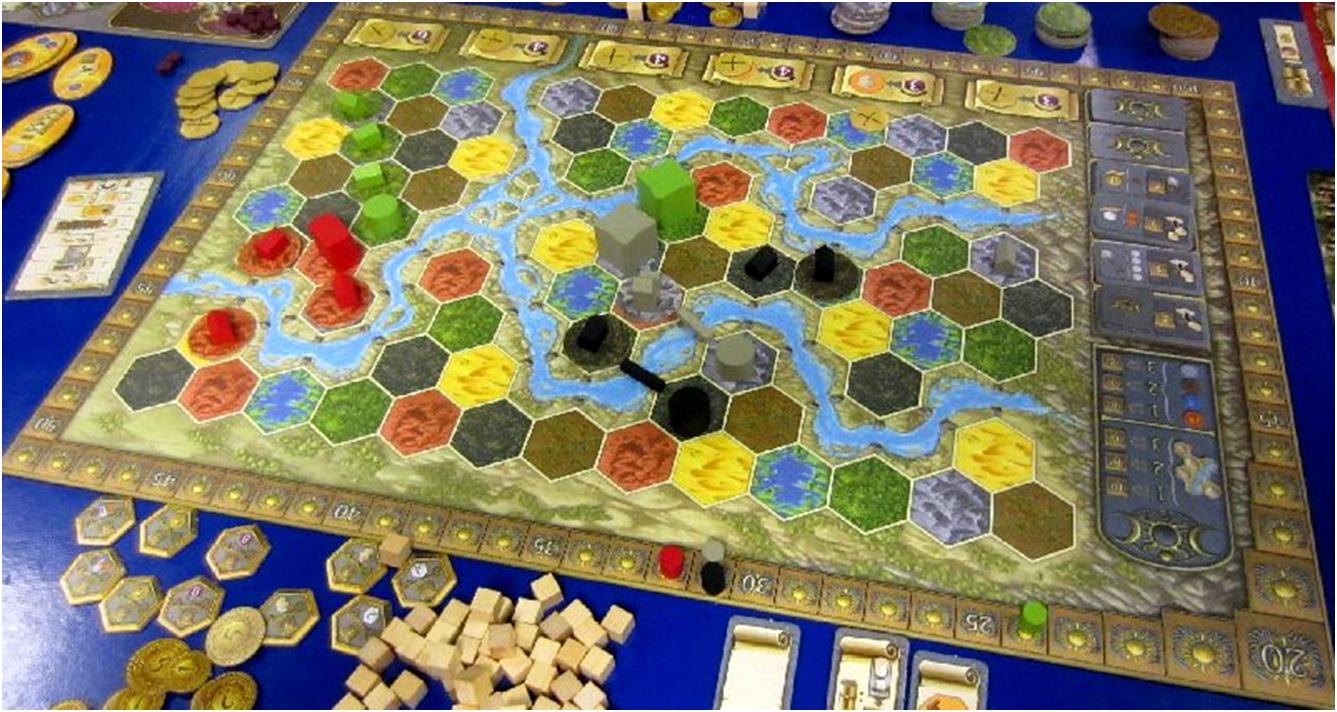
A bit more interesting to me was my position on the cult tracks:
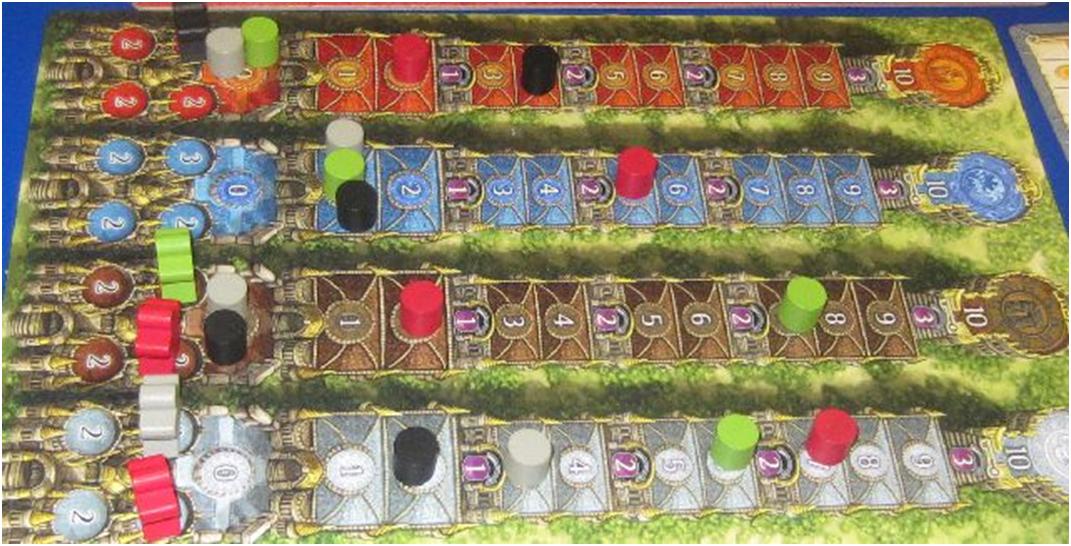
Here I was doing pretty well, although David was ahead of me on the white track.
My main interest in the latter half of the game was expansion, and I had the power and workers to do that, aided by taking the round bonus for terraforming. Sarah also finally got the hang of expanding, although her presence on the cult tracks was dismal. David found himself locked into his corner with not enough expansion prospects, and Rich was building bigger, not wider. Alchemists? Yeah, we’re not sure how to play them!
Rich also found himself trapped on the cult track – he was one turn away from reaching the top of the blue track (a worth achievement) when I got there ahead of him; unfortunately, he hadn’t founded a city and so wasn’t able to reach the final spot. I made two cities and ended up on top of the blue and white tracks, and in first place in the brown track. Sarah got no cult track points at all!
I’m pretty happy with my final expansion: it put me into first place for the largest settlement. I ended up with seafaring 1, so it was all connected – all 11 hexes of it. Sarah noted that the only thing stopping me was that I’d run out of settlements! I really would have liked more trading posts, but the gold cost defeated me; it was quite significant this game.
Sarah ended up with the second largest settlement and Rich was in third place. David had only six buildings on the board in two sets of three – a major disappointment. He did better on the cult tracks.
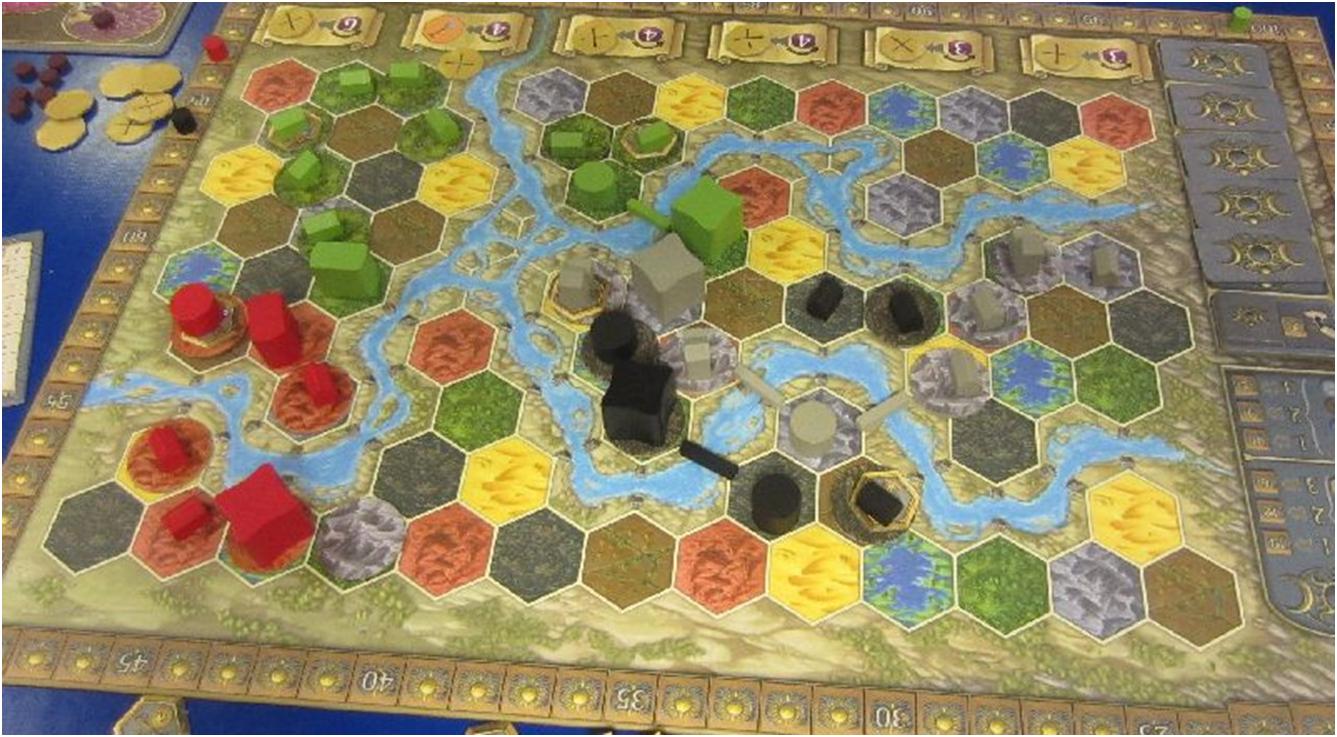
Final Scores:
Merric (green): 99 (18 settlements, 27 cults)
Sarah (grey): 82 (12 settlements, 0 cults)
Rich (black): 67 (6 settlements, 9 cults)
Dave (red): 65 (0 settlements, 17 cults)
I really, really enjoy Terra Mystica and it is a very challenging game. It certainly isn’t for everyone, but if you enjoy Eurogames that involve thinking and planning ahead, this is a game for you. The game isn’t actually that complex, which is important: I can deal with the complexity it has, whilst other games (like Le Havre) I’m in the dark as to the effect of my actions for a large part of the game. In Terra Mystica, the bonuses from the buildings are simple enough so that the combinations make a very elegant and fascinating game.
